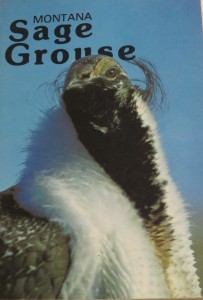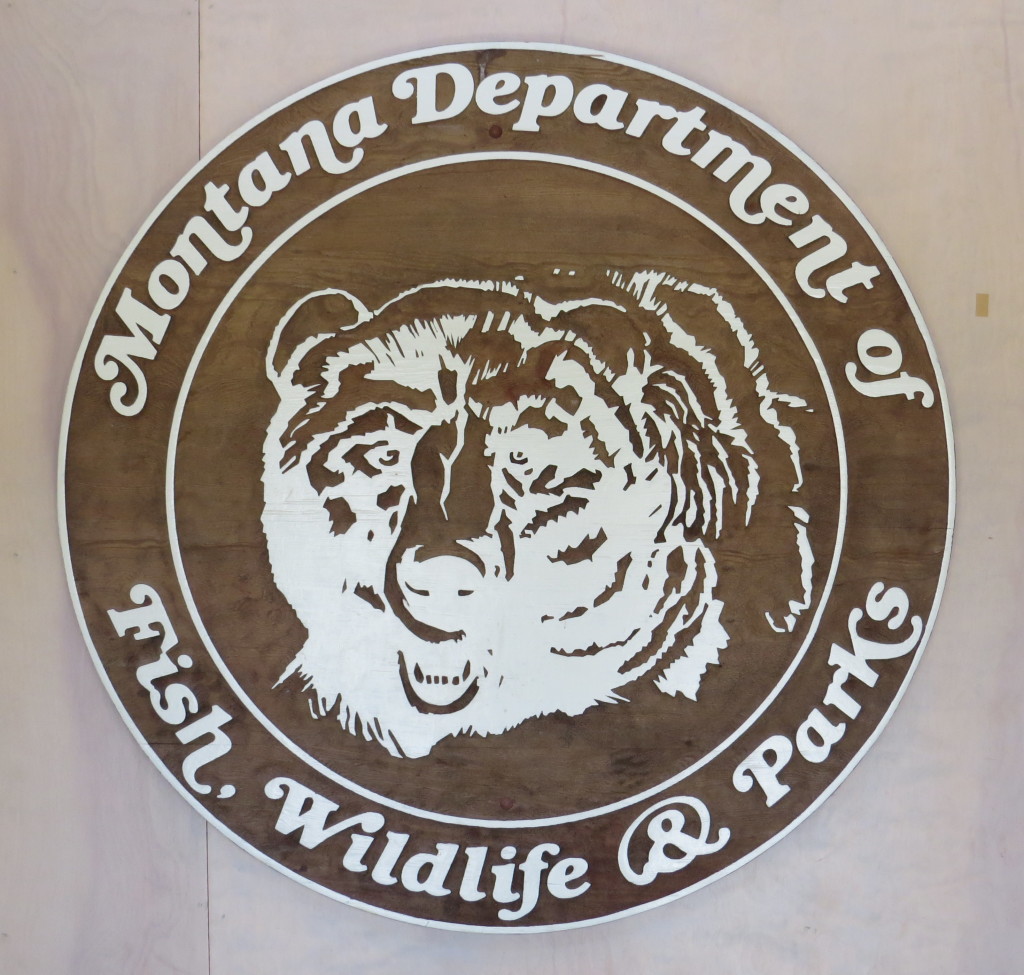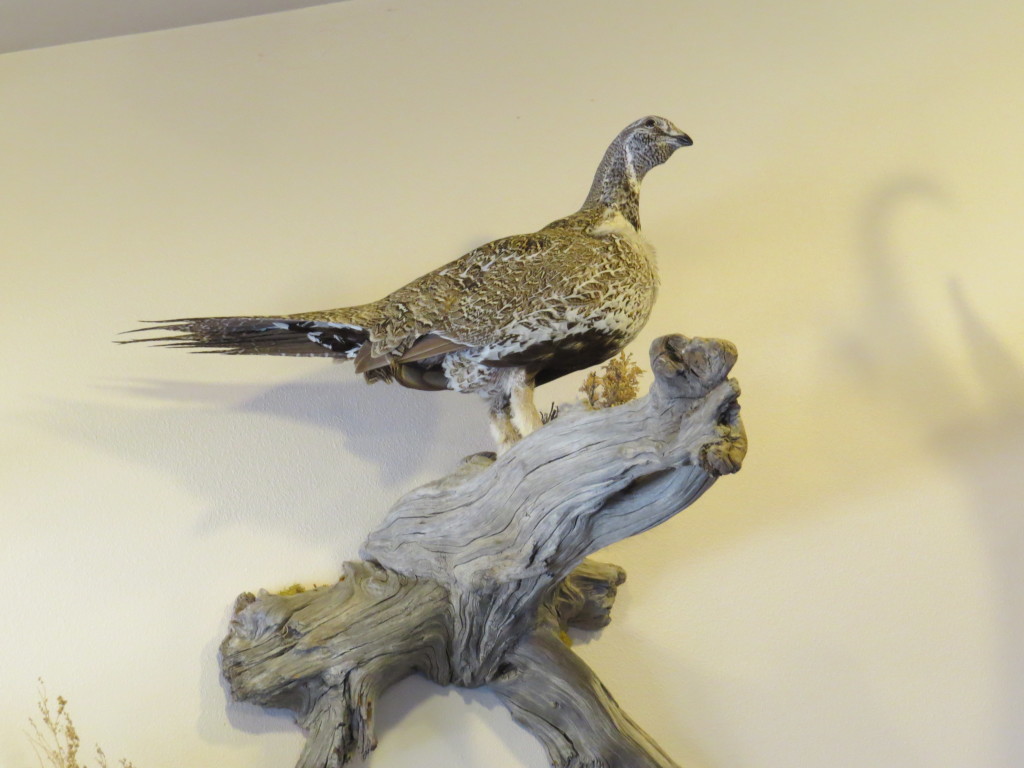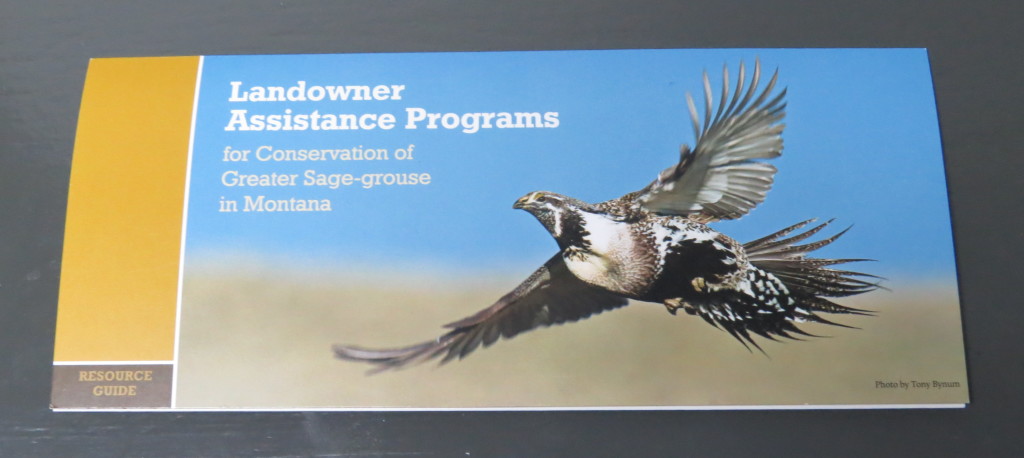 When I was young boy I was mystified by a picture that hung on the wall of my dad’s study. It was a print of the same picture you see on the cover of the book my dad wrote on Greater Sage-Grouse shown on the left. At the time I didn’t even know what I was looking at; it didn’t look like a bird to me at all until one day my dad pointed out the beak and I could finally discern a bird face. Still, it was a bothersome picture, and as a kid I thought this creature was weird and ugly. Oh, little did I know how my opinion would one day change. What I once did not want to look at even in a picture, I was now yearning to see in the flesh. Life was coming full circle in a way–a relatively new hobby was now colliding with my family’s history. As I mentioned in the last post, the Greater Sage-Grouse had been the center of much of my dad’s work at the Montana Department of Fish and Game in the 1970s. I grew up listening to my dad’s stories of this bird’s behavior, stories of him working with this bird, and stories of life in general from my family’s time of living in Montana. Undoubtedly the Greater Sage-Grouse was a key factor in the Big Sky state becoming the birthplace for me and my siblings. Going to see the Greater Sage-Grouse was more than just adding a life bird; it was a chance to see living history. And there would be no better way to do that than in the company of my dad, Rick Wallestad.
When I was young boy I was mystified by a picture that hung on the wall of my dad’s study. It was a print of the same picture you see on the cover of the book my dad wrote on Greater Sage-Grouse shown on the left. At the time I didn’t even know what I was looking at; it didn’t look like a bird to me at all until one day my dad pointed out the beak and I could finally discern a bird face. Still, it was a bothersome picture, and as a kid I thought this creature was weird and ugly. Oh, little did I know how my opinion would one day change. What I once did not want to look at even in a picture, I was now yearning to see in the flesh. Life was coming full circle in a way–a relatively new hobby was now colliding with my family’s history. As I mentioned in the last post, the Greater Sage-Grouse had been the center of much of my dad’s work at the Montana Department of Fish and Game in the 1970s. I grew up listening to my dad’s stories of this bird’s behavior, stories of him working with this bird, and stories of life in general from my family’s time of living in Montana. Undoubtedly the Greater Sage-Grouse was a key factor in the Big Sky state becoming the birthplace for me and my siblings. Going to see the Greater Sage-Grouse was more than just adding a life bird; it was a chance to see living history. And there would be no better way to do that than in the company of my dad, Rick Wallestad.
Serendipity via the World Wide Web
In the last post I mentioned how the interview I did with my dad was a pivotal post. It resonated with many people and sparked the idea for going to Montana to see Sage-Grouse with Dad. One of the best by-products to come of the post was a thoughtful blog comment by John Carlson that showed up out of the blue, long after the interview post was written. I’ll let John’s authoritative words speak for themselves, but they validated both my dad’s past work with Sage-Grouse and my current efforts to chronicle our birding adventures today.
Hi Josh,
I discovered your blog while looking at sage-grouse photos on Google. I saw the cover of your father’s monograph and I had to click on the link. The reason I clicked on it was that book has been in my library since I was a child and I continue to use it to this day. In fact, I used a similar photo in a presentation earlier this summer to describe the important work that Montana has done for sage-grouse over the years. I was much like Evan growing up and I am now working for the BLM in Billings, Montana on sage-grouse with two young boys of my own. I am not sure that I ever met your father when I was growing up in Fort Peck, but I do know Bob Eng and Bob Martinka. Please tell your father how important his work continues to be in our efforts on sage-grouse and he might be interested to know that sage-grouse research is continuing today in the same area he worked (along with research on other grassland and sage associated birds). This time investigating the response to changes in grazing regimes. Anyway, thank you for sharing the discoveries you and Evan are making. As I sat at my cubicle in between meetings and phone calls, it made my day to be reminded of the joys I had as a child when I was birding with my father and I look forward to seeing more. If you ever get this far west, please let me know. I would love to show both of you some of my favorite birds.
It turns out that John is a Conservation Biologist for the federal Bureau of Land Management, Montana Dakotas division. John is the primary BLM person for proactive conservation actions, planning, integration, guidance, and implementation of management for sagebrush dependent special status species in Montana, North and South Dakota with an emphasis on Sage-Grouse. In other words, he’s a modern-day authority on the bird my dad spent so much time with. So as Dad and I talked of going to Montana, we got in touch with John since he would have current intel on active Sage-Grouse leks since my goal was to see strutting Sage-Grouse males. John was more than willing and able to oblige us, and plans started taking shape over this past winter.
Heading West
The whole time I was teaching on Thursday, April 17th, I thought I was absolutely crazy for beginning a trip to Montana at the end of a full day’s work that day. I picked up Evan from school, and by 5:00 we were finally on the road, Bismarck-bound. The North Dakota capital would be our stop for the night, roughly the halfway point of the 775-mile drive to Billings. The landscape of western Minnesota and eastern North Dakota is bleak, and at the time we were traveling, also dark. As Evan coped with the nothingness by watching videos and playing iPad, I was left alone with my thoughts. One such thought was that our travel was symbolic as it was bringing through Minnesota, North Dakota, and Montana–the respective birth states of Evan, Dad, and myself.
After spending a night in a dismal room reserved especially for Priceline customers, I was eager to get back on I-94 and head west again. We were now traveling in the better half of North Dakota, enjoying the rugged hills and breaks in all of morning’s glory as the rising sun was at our backs. Passing through Theodore Roosevelt National Park was especially inspiring. Evan and I were anxious to cross into Montana, though. For him it was a new state. For me it was a reunion with my past and with a state I don’t get to see often enough. Big Sky country did not fail to leave us in awe. There’s just something about that state that’s so good for the soul.
In Billings we would be meeting up with my parents who were home-bound from wintering in Arizona. Together we would all be staying with long-time family friends, Leo and Jo Jurica. Getting to see the Juricas was a wonderful bonus to what was sure to be a trip of a lifetime. Since Evan and I got to Billings mid-afternoon, I decided to poke around Lake Elmo State Park in the hopes of picking up a lifer California Gull. No Gulls were around, but it was a fitting and pleasant surprise to unexpectedly come across a Montana Department of Fish, Wildlife, & Parks office. The moniker may be a bit different today, but this was still Dad’s former employer and worth checking out, especially considering the focus of our trip.

Offices such as these are always fun to visit. There are educational displays and numerous mounts of birds and mammals to check out. One mount stood out among the rest.

There are numerous free publications at these offices. In addition to a nice, free road-map of Montana (score!), one pamphlet in particular caught my eye.

It was a reminder that the fate of the Greater Sage-Grouse is currently under intense scrutiny. As a sagebrush dependent species, there has long been a concern over the protection of this unique bird’s habitat. Ever since settlers first carved out farms from the native prairies, man has sought the removal and destruction of sagebrush in order to convert the land into grassland for cattle grazing. According to my dad’s book, this habitat decimation reached its heyday in the 1950s when planes started being used to spray the herbicide 2,4-D. By the time wildlife agencies caught on to this effective technique, millions of sagebrush acres had already been lost. Dad’s work with the Greater Sage-Grouse was part of a 10-year joint study between the Montana Department of Fish & Game and the Bureau of Land Management to determine the effects of sagebrush control on sagebrush dependent species, like the Sage-Grouse. Though the spraying of sagebrush eventually stopped, the alarm bells are still ringing loudly as the USFWS designated the Greater Sage-Grouse as a candidate for being listed as an endangered species, a fate which will be determined by the fall of 2015. John Carlson told us how they are working hard to keep it off the “List” as such a designation would have huge implications on the economy and everyday life of people sharing the land with these birds. Because of this, many landowners are voluntarily cooperating with state and federal agencies to promote the conservation of this species. Sadly, John told us other landowners are now tilling under their sagebrush in anticipation of the listing to avoid the hassles associated with owning prime habitat for an endangered species.
Not only were Evan and I about to see a bird that is important to our family’s history, but we were about to see an important bird period. The trip was becoming more and more significant.
The Meeting
Once in Billings, I got in touch with John Carlson. John wanted to have a face-to-face meeting that night to go over plans for the big adventure that would happen the following morning. We decided to meet up at a local McDonald’s where John, Dad, and I were joined by one of Dad’s Fish & Game biologist colleagues, Charlie Eustace. Evan stayed back at Juricas’ house with Grandma since it was late and we’d be getting up very early the next morning.
It was fun to finally meet John as well as Charlie, whose name I have often heard in Dad’s stories and recollections of his Fish & Game days. The hour-long conversation that followed was one of my favorite and most memorable parts of the trip. John, Charlie, and Dad reminisced over mutual friends and acquaintances. These three biologists also shared stories and misadventures of work in the field, creating much laughter and sore cheeks–I even got to hear some new stories from Dad. It was also fun to watch the old guard listen to John talk about about new studies and capture techniques for Sage-Grouse. Dad seemed to be in awe of the ability to monitor movements of live birds on a computer in an office because of satellite tracking. Likewise, it was interesting to learn that radio telemetry, which was cutting edge in Dad’s day, is still a very common and inexpensive means of keeping tabs on Sage-Grouse today. One of the more poingnant moments in the conversation was when John told Dad that much of Dad’s work was foundational for studies that are being done today, and then John went on to thank Dad for his work. It was pretty cool to witness.
We did, of course, discuss plans for the next morning. John had picked a large, active Sage-Grouse lek for us to go see about 45 minutes northwest of Billings near Lavina. After watching the courtship display from a blind on the edge of a lek in the pre-dawn and early morning hours, the plan was to then go visit the Yellow Water Triangle north of Roundup where Dad conducted his Sage-Grouse studies.
John told us we needed to leave Billings by 4:00 AM to get to the blind well before daylight. So we all parted company and went home so we could get some rest before the next day. The clock said it would be a short night, but as visions of seeing this bird the next morning flashed through my head, it would prove to be one of the longest nights I can remember.
The story of our Montana Greater Sage-Grouse Lifer with Rick Wallestad is made up of four parts: 1) The Prologue–The Impetus, 2) Part 1, 3) Part 2, and 4) The Epilogue–Bonus Lifers.
